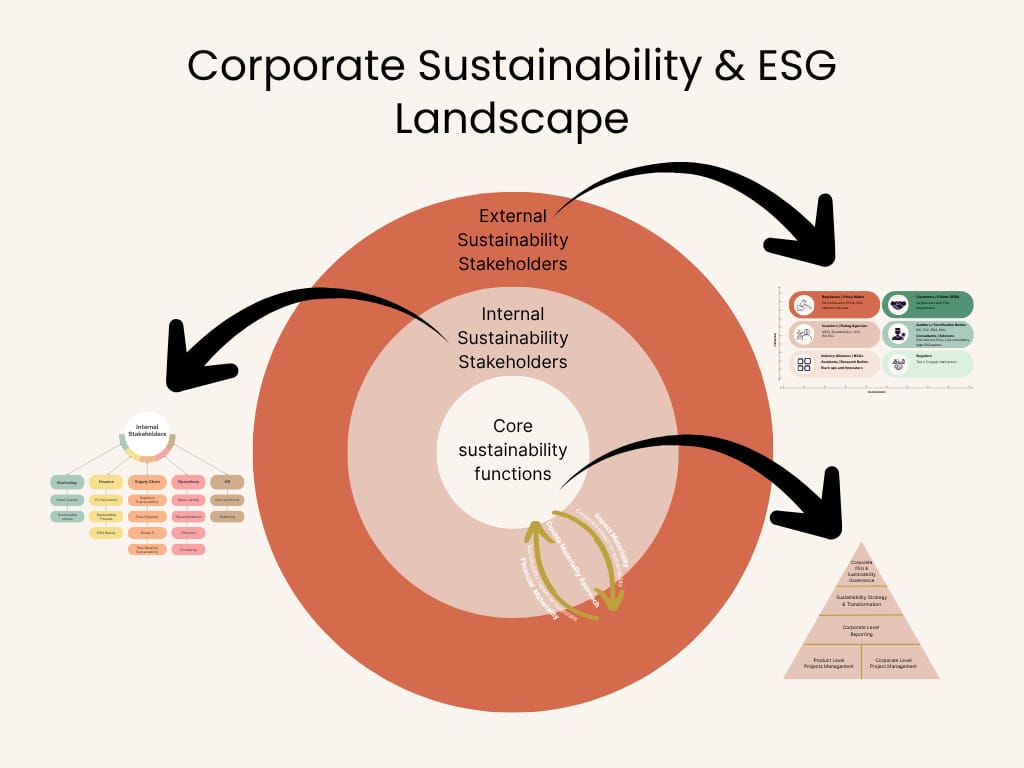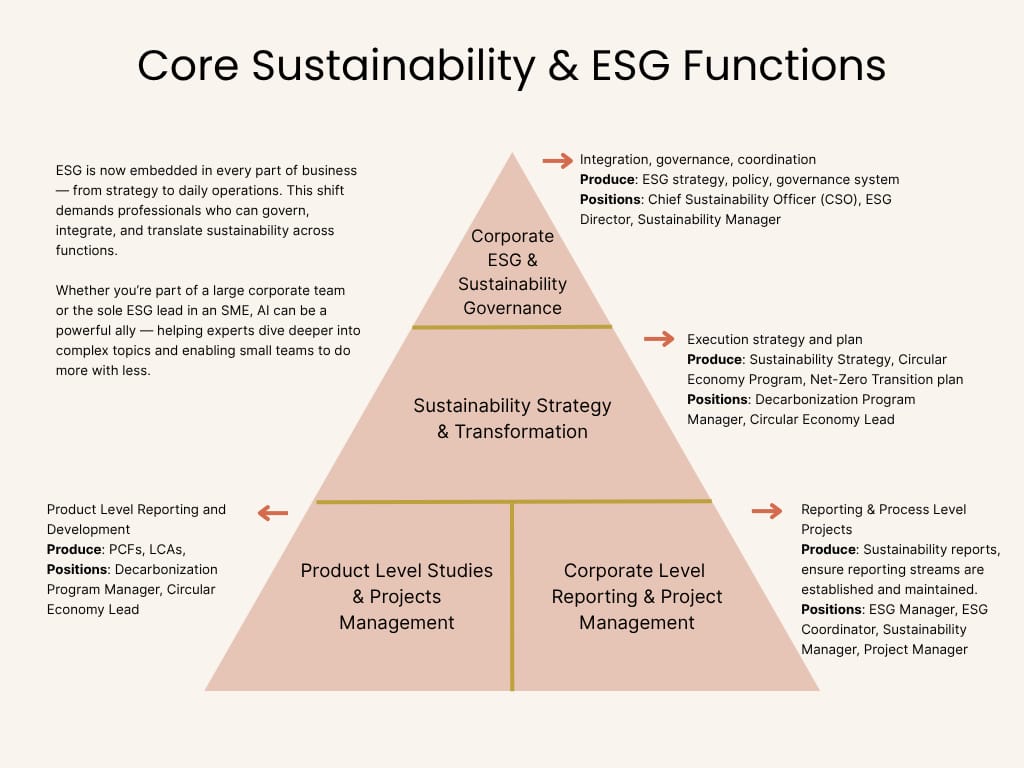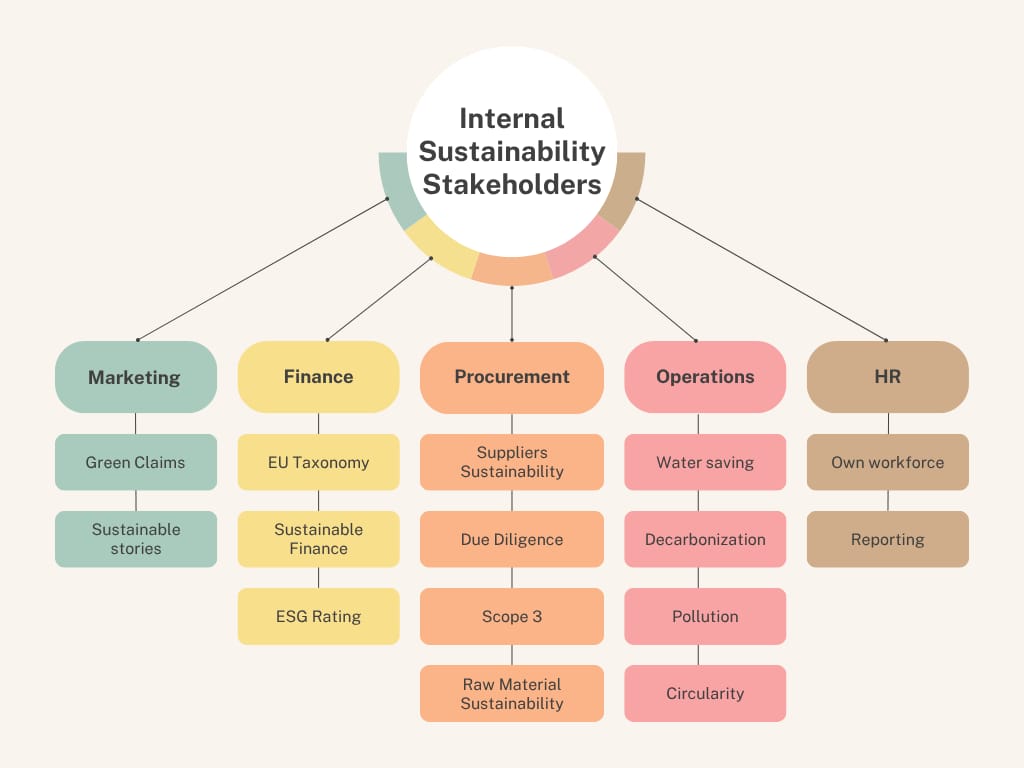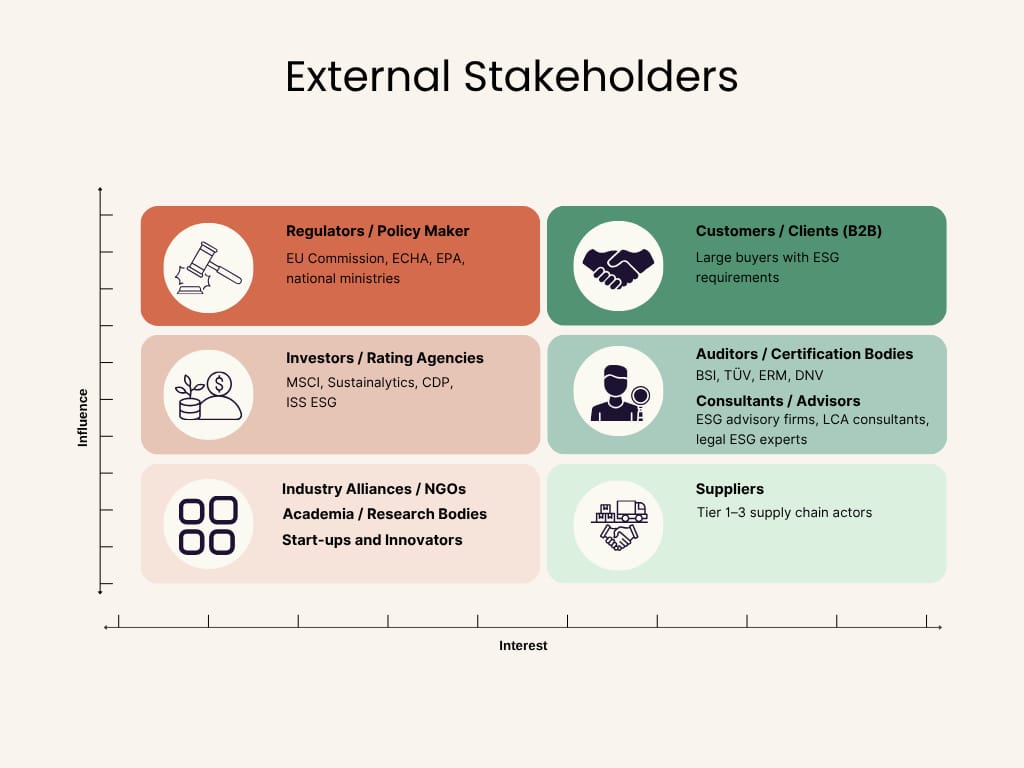You’ve probably seen hundreds of sustainability roles with titles like “Sustainability Manager” or “ESG Analyst”. But are they all the same? And what do they actually mean? In a field exploding with both opportunity and ambiguity, finding your path starts with understanding the system.
In Today's Newsletter
Sustainability is booming, from climate tech startups to ESG roles in Fortune 500s, the career opportunities seem endless.
But for most professionals, the path in feels foggy. Job titles all sound the same, descriptions are vague, and it’s hard to know where you actually fit in. That’s because “sustainability” isn’t one job! It’s a system of interconnected roles across functions, industries, and layers of influence. In this article, we’ll break down that system into a simple framework you can use to navigate the noise, find your place, and make your pivot with purpose.
Why Sustainability Careers Feel So Confusing
Sustainability is no longer a one-person job — or even a one-department initiative. It touches every part of the business. Procurement teams are evaluating suppliers and conducting ESG due diligence. Finance is approving green budgets and reporting on them. Product development is factoring in life cycle analysis, while operations teams are optimizing for energy and resource efficiency.
The field has matured, not only in scope but in its ability to show real ROI. That’s why companies are taking it seriously, and why the shift is becoming visible across the job market. If you haven’t read LinkedIn’s latest Green Jobs report, it’s worth a look [Link]. The demand for green skills is higher than ever and interestingly, it’s growing fastest outside of formal sustainability teams.
Wait! What? Outside sustainability teams!
Yes, the growth is actually happening in the rest of the business. Sustainability has become embedded in every department.
But with growth comes complexity. And for many professionals trying to enter the space, the landscape feels messy and confusing. That’s exactly why I’m writing this! To offer a clear, practical map so you can understand the ecosystem and make your shift with confidence.
Why Sustainability in 2026 Is Still a Smart Career Move
Despite market shifts and economic uncertainty, the sustainability field continues to grow — and not just in theory. The green economy is now valued at $7.9 trillion, making up 8.6% of global listed equities and ranking as the fourth-largest industrial sector. This isn’t just hype. It’s a clear signal that sustainability is becoming a permanent pillar of the business world.
The momentum is also regulatory. New rules like the CSRD in Europe, the SEC’s climate disclosure requirements in the US, and ISSB’s global standards are driving demand for professionals who understand ESG, climate data, and impact reporting. This means sustainability fluency is quickly becoming a core skill, not a niche specialty.
On top of that, sustainability is no longer isolated. It’s cross-functional. Companies now need people who can integrate sustainability into finance, supply chain, operations, product, and beyond. That shift is unlocking new job opportunities in places many professionals haven’t thought to look.
Too Much Is Going On! Subscribe To My YouTube!
If you haven’t subscribed to my YouTube channel yet, you’re seriously missing out on practical, no-fluff content at the intersection of sustainability, career growth, and AI.
We’re just 342 subscribers away from hitting 500 — a milestone I’ve set for myself by the end of this year.

If you’ve found this article helpful, I’d love for you to join me on that journey. Let’s build a smarter, more skilled sustainability community together.
Do you think we can make it?
Let’s be honest. Trying to figure out where you fit in sustainability can feel like staring at a puzzle with half the pieces missing.
Job titles vary wildly between companies. A "Sustainability Analyst" at one firm might focus on carbon accounting, while at another, the same title could mean working on supply chain strategy or policy engagement. Which can be challenging to understand what is missing and start building the skills you would need to get the right job for you.
The bigger truth? Sustainability isn’t a single job or function. It’s a complex, interconnected system that blends business, science, data, operations, policy, and communication. That’s part of what makes it so exciting, but it’s also what makes the entry paths unclear.
Without a clear framework, most people end up guessing. They apply to roles they don’t fully understand or assume they need to go back to school. But what they really need is a better map of the system.
The Sustainability Ecosystem: The 3 Layers
If “sustainability” feels like a moving target, it’s because we’ve been treating it like a single lane, when in reality, it’s a multi-layered ecosystem.
Here’s a simple way to think about it:
Core. Internal. External.

Every sustainability role fits into one of these three layers:
Core is the central ESG or sustainability team. They own governance, strategy, and reporting.
Internal includes roles across departments like finance, operations, procurement, HR, and marketing, where sustainability gets embedded into day-to-day business.
External refers to the broader ecosystem: consultants, auditors, SaaS tools, NGOs, regulators, and others influencing how companies act.
Each layer plays a different role. Each demands a different set of skills. And each offers different opportunities for professionals looking to pivot in.
Once you understand these layers, the career landscape starts making a lot more sense.
Layer 1: The Core Functions — Where the Formal Sustainability Work Happens
This is what most people picture when they think of a “sustainability job.” The Core team is responsible for setting strategy, maintaining governance, and managing ESG and climate disclosures.

Here’s what they actually do:
Governance: Setting up internal policies, sustainability committees, and accountability structures.
Strategy: Defining long-term goals, climate roadmaps, and target-setting (think net zero, circularity, DEI).
Reporting: Managing frameworks like CSRD, TCFD, GRI, or SASB. Ensuring data quality, coordinating assurance, and publishing ESG reports.
Typical roles include ESG analyst, reporting specialist, climate strategist, and sustainability PMO.
These roles often sit at the center of the organization, working cross-functionally to pull data, align goals, and push progress. They’re structured, high-impact and in growing demand due to regulatory pressure.
Pivot Technique #1: The Core Entry
Start with relevant study or certification, land an analyst or reporting internship, and grow into strategy or governance from there. This is often the cleanest path in, especially for early-career professionals or career changers with strong research, data, or project management skills.
Layer 2: Internal Stakeholders — When Sustainability Becomes Everyone’s Job
Sustainability doesn’t live in a silo. It shows up in every department and that’s where many of the real shifts are happening today.

Here’s how different teams contribute:
Finance: Green budgeting, sustainable investment analysis, ESG risk integration.
Procurement: Supplier sustainability assessments, ethical sourcing, scope 3 emissions tracking.
HR: Embedding DEI, employee engagement, training on ESG topics, aligning incentives.
Operations & Engineering: Decarbonization, process efficiency, waste and pollution control.
Marketing & Comms: Telling the impact story transparently, avoiding greenwashing, aligning messaging with real data.
These aren’t just “supporting” roles. They’re frontline actors in delivering sustainability goals.
Pivot Technique #2: The Internal Cross-Functional Shift
Instead of starting over, leverage your existing skills. If you’re already in one of these departments, you can expand your scope, lead a sustainability initiative, or transition into a sustainability-dedicated role within your function. Many companies now prefer internal hires for these hybrid roles, they already know the business and can layer sustainability on top.
Layer 3: External Stakeholders — The Bigger Universe Beyond the Company
While internal teams drive implementation, external players shape the standards, tools, and pressure that keep sustainability moving. This external layer is growing fast — and it’s packed with career opportunities.

Key players include:
Consulting & Advisory Firms: Help companies build ESG strategies, navigate reporting requirements, or decarbonize operations.
Auditors & Certification Bodies: Provide assurance for sustainability disclosures and verify compliance with ESG standards.
SaaS & AI Tools: Develop platforms for carbon accounting, ESG data management, life cycle analysis, and reporting automation.
Regulators & Policymakers: Set the rules that define what “good” sustainability looks like — and enforce it.
NGOs, Alliances & Industry Groups: Push for transparency, create frameworks, and support collective action across sectors.
These actors play a critical role in pushing the field forward — and they need people who understand both industry and sustainability.
Pivot Technique #3: The Industry Expert Shift
If you’ve built deep expertise in a specific industry or function, you can transition into consulting, product, or advisory roles focused on sustainability. The learning curve is shorter than you think — and your background becomes a huge asset.
This Week’s Prompts: Prepare for Your ESG Consulting Call
As a sustainability professional, I never jump on a call with a consultant without running these 3 ChatGPT prompts first. I learned this the hard way — and I’m sharing them so you don’t have to.
Here’s the truth: 50% of most intro calls with consultants are wasted on basic overviews you could’ve prepared for in minutes. And let’s be honest… consultants don’t enjoy those calls either.
These prompts help me show up aligned, focused, and ready to collaborate. If you’ve got a consulting call coming up — save these:
✔️ Prompt 1 — Get Clear on Your Goal
I'm preparing for a first-time call with a consultant regarding a new [regulation]. My goal is to understand the [insert discovery goal: e.g., scope of the regulation, expected operational impact, or data I need to collect]. Draft a focused agenda for a [duration] call, including: - intro - key discussion points - clear next steps Keep it practical and relevant for a company in the [industry].
✔️ Prompt 2 — Gather the Right Inputs
To prepare for a discussion about [regulation], what are the top 5 pieces of information I should have ready as a Sustainability/ESG Manager in the [industry]? Explain why each one matters for understanding compliance gaps or impact areas.
✔️ Prompt 3 — Prepare Sharp, Insightful Questions
Generate 10 well-structured, insightful questions for a consultant specializing in [regulation]. Cover: [financial impact, operational changes, future strategy, etc.].
This last one not to ask those questions but to complete your research based on the questions provided, in case you felt you would like to get deeper.
If you’re a sustainability professional, you probably know exactly what I mean.
Those first-time calls can be… painful. Use these prompts and show up prepared next time!
Closing Note: The ESG Masterclass
For those who don’t know me — I started out as a chemical engineer before deciding to shift careers and step into the ESG field. Like many of you trying to land your first ESG role, the journey was tough. What made it harder was the lack of clear guidance — no blueprint, no roadmap on where to focus or how to build the right skills.
That’s exactly why I created the ESG Masterclass It’s designed to give you the know-how to land your first ESG role, plus the trusted sources you need to keep learning and growing in this fast-changing field.
Over 300 professionals have already joined, and the feedback has been fantastic. If you’re ready to take your ESG career to the next level, you can join now with a 50% discount.


